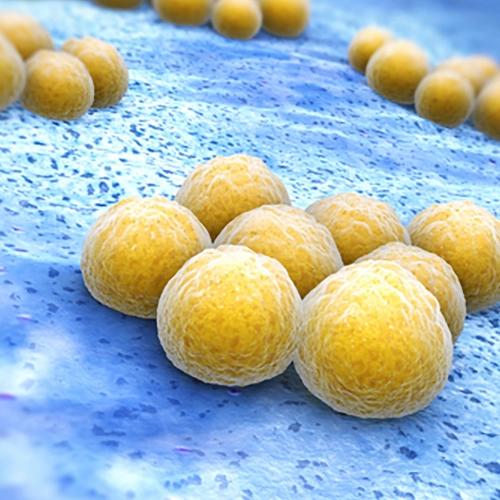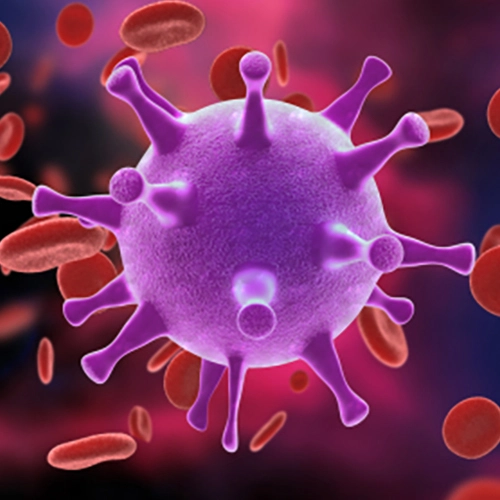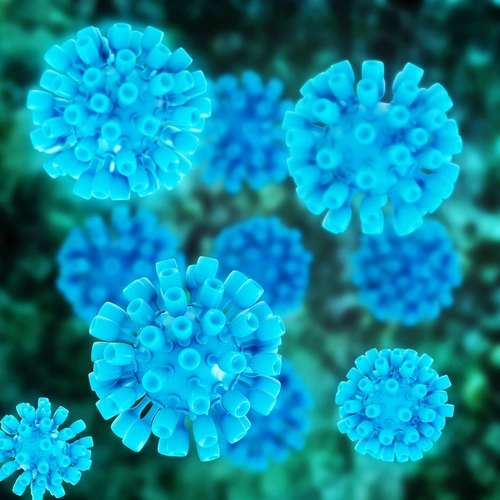Both bacteria and viruses can cause disease in humans, some of which are mildly irritating while others can be fatal.
But what’s the difference between bacteria and a virus?
Bacteria are typically much larger than viruses, sometimes up to 1000 times! Bacteria are also single-celled organisms that reproduce asexually, independently of other organisms. Viruses, on the other hand, need the aid of a living cell in order to reproduce.
Common illnesses caused by bacteria and viruses:
Infections can be caused by both viruses and bacteria, but it’s not always clear which illness is caused by what or how they spread in the first place.
Below, we’ve identified some of the most common infections and sectioned them into bacterial and viral infections. Sometimes, it can be hard to identify if the infection is bacterial or viral; in some cases—such as meningitis and pneumonia—it could be either.
| Bacterial infections | Viral infections |
|---|---|
| Pneumonia | Pneumonia |
| Tuberculosis | Rabies |
| E.coli | Ebola |
| MRSA | Zika |
| Listeria | HIV |
| Strep throat | Polio |
| Urinary Tract Infections (UTI) | Measles |
| Tonsillitis | Chickenpox |
| Septicaemia (blood poisoning) | Flu |
So now we know that bacteria and viruses are fundamentally different, is there any difference in how long they survive outside of the human body?
Below, we take a look at the most common bacteria and viruses and their common survival rate once they’re outside the body…
The Common Cold
How long it lasts:
Viruses can sometimes survive on indoor surfaces for more than a week and, in general, they will survive on non-porous surfaces for longer. So surfaces such as stainless steel and ceramic tiles can house viruses for much longer than non-porous materials such as fabrics or tissues.
However, although the common cold virus has been shown to survive on surfaces for several days, their ability to cause infections quickly diminishes; they usually cannot cause infections after 24 hours.
But how long can the cold virus survive on our hands?
Some of the viruses that cause the common cold can only survive on hands for a short period of time, with some lasting just a few minutes. However, around forty per cent of rhinoviruses—a common cold-causing virus—are still infectious on hands after an hour.
Respiratory Syncytial Virus (RSV) is a cold-like virus which can cause serious illness in children. It can survive on worktops and door handles for up to six hours, on clothing and tissue for 30–45 minutes, and on skin for up to 20 minutes.
How it spreads:
The common cold is transferable between hands and surfaces and is extremely contagious. If you have the virus, you are infectious until all of your symptoms have gone.
To avoid spreading it to others, make sure that you wash your hands often with warm soapy water, and try to trap germs with tissues when you sneeze and/or cough, throwing them away straight after.
Flu Virus
How long it lasts:
While it’s important to wash hands regularly when you have the flu, it’s also important not to ignore the cleaning of surfaces around your home or building to help prevent it from spreading.
The flu virus can survive on hard surfaces for 24 hours, during which time it is transferable to hands. Surprisingly, it only survives for around 15 minutes on tissues and on hands for a much shorter duration; levels fall on hands after just five minutes.
The flu virus can survive as droplets in the air for several hours, with low temperatures increasing their survival rate.
Parainfluenza—which can cause croup in children—can survive for ten hours on hard, non-porous surfaces, and for four hours on porous materials.
How it spreads:
The flu and the common cold are very similar and often, it’s hard to decide if you have one or the other. However, there are subtle differences, including the likelihood of passing it on. While with the common cold, you are highly contagious all the time you are experiencing symptoms, you’re much more likely to pass the flu virus on within the first five days.
However, you can avoid passing it on by following the same advice as for colds; wash hands often with warm soapy water and catch sneezes and coughs with tissues and throw them in the bin straight away.
Stomach bugs
How long they last:
Salmonella and campylobacter survive for around one to four hours on hard surfaces and fabrics. Norovirus and C.diff, however, can survive for much longer. In fact, one study found C.diff to survive for five months!
Norovirus—which spreads via droplets in the air when somebody vomits before landing on surfaces—can survive for a few days to a few weeks on hard surfaces.
E.coli can live for a few hours to a day outside of the human body.
How they spread:
Alcohol hand gel doesn’t kill norovirus. You can catch it by being in close proximity to somebody who has it, touching surfaces contaminated with it then touching your mouth, or by eating food prepared or handled by somebody with it. Hand hygiene—using warm water and soap—is vital in stopping norovirus from spreading.
E.coli is usually spread through faecal matter reaching the mouth. Therefore, it’s essential to wash hands properly with warm water and soap after using the bathroom, handling animals, or before preparing food.
MRSA

How long it lasts:
The staphylococcus aureus bacteria is responsible for wound infections, toxic shock syndrome, and MRSA. It forms spores that allow it to survive for weeks on fabric.
MRSA bacteria can live on surfaces for longer than other bacterias and viruses as they survive much better without moisture. Generally, MRSA bacteria survives better on hard surfaces, and any contaminated fabrics should be washed at a minimum of 60°C with a bleach-based detergent.
How it spreads:
MRSA harmlessly lives on the skin of around 1 in 30 people. You can get the bacteria on your skin relatively easily; by touching somebody with it, by sharing towels, bedsheets or clothes with somebody with it, or by touching surfaces with it.
However, getting MRSA on your skin alone isn’t enough to make you ill. Often, it will leave your skin without you ever knowing you had it. This can be as quick as a few hours or could take a couple of weeks. But to make you ill, it needs to get deeper into your skin for example, via a wound or sore.
HIV

How long it lasts:
HIV doesn’t live long outside of the body while it’s in the air. As soon as fluid leaves the body and is exposed to air, it quickly begins to dry up. This damages the virus, making it inactive. Once inactive, the HIV virus is “dead” and is no longer infectious. This can take as little as just a few hours.
When a bodily fluid containing HIV leaves the body and lands on a surface, the virus remains active within the fluid for several days, even as the fluid dries. The virus gradually dies over the course of several days, however, it’s important to note that the amount of the virus able to transmit an infection in such a small volume is negligible.
HIV in a syringe, however, survives much longer. According to the CDC (Centers for Disease Control and Prevention), the HIV virus can survive up to 42 days in a syringe, and under the right conditions.
How it spreads:
HIV is found within the bodily fluids of an infected person. This includes semen, vaginal and anal fluids, blood, and breast milk.
HIV cannot be transmitted through sweat, urine or saliva. The most common way of contracting HIV in the UK is through sex without the use of a condom. However, you can still get HIV by sharing needles, syringes or other injecting equipment and it is possible to pass the virus from mother to baby during pregnancy, birth or breastfeeding.
Hepatitis A, B, and C

The Hepatitis A virus can stay infectious for months and is transmitted via the faecal to oral route and is highly contagious.
Whereas Hepatitis B remains infectious for up to a week and is transmitted via bodily fluids and as such, isn’t as bigger a threat as Hepatitis A.
Hepatitis C can live outside of the body for up to four days, but most experts believe that it typically survives for up to 16 hours at room temperature. Hepatitis C is also transferred via bodily fluids.
Life outside the body
While viruses do best on hard surfaces, bacteria are more likely to persist on porous materials. In general, bacteria remain infectious longer than viruses.
How long bacteria lives outside the body depends on how different external conditions are to their preferred environment and whether or not the bacteria are capable of producing spores.
Spores can survive even in adverse conditions for a long time, for example, spores of the anthrax bacterium can survive for decades, even centuries.
What you can do to help protect against bacteria and viruses
As mentioned above, the single most important thing you can do to help prevent illnesses from spreading is practising good hand hygiene using warm water and soap.
Hands should be washed for 20 seconds (about the time it takes to sing ‘Happy Birthday’ twice) and should be washed:
- Before, during, and after preparing food
- Before eating food
- Before and after caring for someone who is sick
- Before and after treating a cut or wound
- After using the toilet
- After changing diapers or cleaning up a child who has used the toilet
- After blowing your nose, coughing, or sneezing
- After touching an animal, animal feed, or animal waste
- After handling pet food or pet treats
- After touching garbage
If you need a little more help in infection control, contact us today to discuss Air and Surface Decontamination.
Our BioSweep Surface Defence uses an antimicrobial solution that binds at the molecular level with any treated substrate. Rendering the entire surface antimicrobial.
A physical barrier of carbon chains is created. Which point up like tiny swords, penetrating any microbe which lands on the surface. This action prohibits any bacteria, viruses and mould from growing on the treated surface.
Areas treated with the BioSweep Surface Defense can be cleaned as usual without it being washed off. It can withstand temperatures up to 125°C and can resist all organic solvents, strong acids and bases.
It will begin to lose its maximum potency within 12 months, however, so should be reapplied every 10 – 12 months for optimum results and protection.



